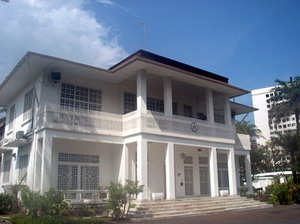| Gabon, officially
the Gabonese Republic, is a country in west central Africa. It borders
on Equatorial Guinea, Cameroon, Republic of the Congo and the Gulf of Guinea.
Since its independence from France on August 17, 1960, the Republic has
been ruled by only two autocratic Presidents; the incumbent El Hadj Omar
Bongo Ondimba has been in power since 1967 and is currently (2007) Africa's
longest-serving Head of State. Gabon introduced a multiparty system and
a new democratic constitution in the early 1990s that allowed for a more
transparent electoral process and for reforms of governmental institutions.
A small population, abundant natural resources, and foreign private investment
have helped make Gabon one of the most prosperous countries in the region.
Its coat of arms shows two jungle cats representing their prided animals.
Gabon is located on the Atlantic
coast of central Africa. Located on the equator, Gabon has an equatorial
climate with an extensive system of rainforests covering 85% of the country.
There are three distinct regions: the coastal plains (ranging between 20
to 300 km from the ocean's shore), the mountains (the Cristal Mountains
to the northeast of Libreville, the Chaillu Massif in the centre, culminating
at 1575 m with Mont Iboundji), and the savanna in the east. The coastal
plains form a large section of the World Wildlife Fund's Atlantic Equatorial
coastal forests ecoregion and contain patches of Central African mangroves
especially on the Muni River estuary on the border with Equatorial Guinea.
 Gabon's
largest river is the Ogooué which is 1200 km long. Gabon has three
karst areas where there are hundreds of caves located in the dolomite and
limestone rocks. Some of the caves include Grotte du Lastoursville, Grotte
du Lebamba, Grotte du Bongolo, and Grotte du Kessipougou. Many caves have
not been explored yet. A National Geographic Expedition visited the caves
in the summer of 2008 to document them. Gabon's
largest river is the Ogooué which is 1200 km long. Gabon has three
karst areas where there are hundreds of caves located in the dolomite and
limestone rocks. Some of the caves include Grotte du Lastoursville, Grotte
du Lebamba, Grotte du Bongolo, and Grotte du Kessipougou. Many caves have
not been explored yet. A National Geographic Expedition visited the caves
in the summer of 2008 to document them.
Gabon is also noted for efforts
to preserve the natural environment. In 2002, President Omar Bongo Ondimba
put Gabon firmly on the map as an important future ecotourism destination
by designating more than 11% of the nation's territory to be part of its
national park system (with 13 parks in total), one of the largest proportions
of nature parkland in the world. Natural resources include: petroleum,
magnesium, iron, gold, uranium, and forests.
Tourism
Straddling the equator, this
rainforest nation is situated on West Africa’s Atlantic coast. Animals
are abundant – Gabon is the continent’s fifth least densely populated country
– and is 85 per cent covered in tropical forest.[citation needed] This,
along with savannahs, mangroves, lagoons and beaches makes it an ideal
habitat for varied species of animals and reptiles including 20,000 western
lowland gorillas and 60,000 forest elephants – the largest population in
Africa – and 700 types of exotic birds.
The National Tourism Strategy,
written in consultation with the The Wildlife Conservation Society, aims
to achieve 100,000 visitors per annum. |

